Athens
Athens
Αθήνα | |
|---|---|
Capital city | |
|
UTC+3 (EEST) | |
| Postal codes | 10x xx, 11x xx, 120 xx |
| Telephone | 21 |
| Vehicle registration | Yxx, Zxx, Ixx |
| Patron saint | Dionysius the Areopagite (3 October) |
| Major airport(s) | Athens International Airport |
| Website | cityofathens.gr |
Athens (
Athens is one of the
In modern times, Athens is a huge cosmopolitan
The heritage of the
Etymology and names
In
According to the ancient Athenian
During the medieval period, the name of the city was rendered once again in the singular as Ἀθήνα. Variant names included Setines, Satine, and Astines, all derivations involving
History
Kingdom of Athens 1556 BC–1068 BC
City-state of Athens 1068 BC–322 BC
Hellenic League 338 BC–322 BC
Kingdom of Macedonia322 BC–148 BC
Roman Republic 146 BC–27 BC
Roman Empire 27 BC–395 AD
Eastern Roman Empire 395–1205
Duchy of Athens 1205–1458
Ottoman Empire 1458–1822, 1827–1832
Greece 1822–1827, 1832–present
Antiquity
The oldest known human presence in Athens is the Cave of Schist, which has been dated to between the 11th and 7th millennia BC.
By the sixth century BC, widespread social unrest led to the reforms of Solon. These would pave the way for the eventual introduction of democracy by Cleisthenes in 508 BC. Athens had by this time become a significant naval power with a large fleet, and helped the rebellion of the Ionian cities against Persian rule. In the ensuing Greco-Persian Wars Athens, together with Sparta, led the coalition of Greek states that would eventually repel the Persians, defeating them decisively at Marathon in 490 BC, and crucially at Salamis in 480 BC. However, this did not prevent Athens from being captured and sacked twice by the Persians within one year, after a heroic but ultimately failed resistance at Thermopylae by Spartans and other Greeks led by King Leonidas,[39] after both Boeotia and Attica fell to the Persians.

The decades that followed became known as the

By the mid-4th century BC, the northern Greek kingdom of

In the early 4th century AD, the
The city remained an important center of learning, especially of
Middle Ages
The city was threatened by
Invasion of the empire by the Turks after the Battle of Manzikert in 1071, and the ensuing civil wars, largely passed the region by and Athens continued its provincial existence unharmed. When the Byzantine Empire was rescued by the resolute leadership of the three Komnenos emperors Alexios, John and Manuel, Attica and the rest of Greece prospered. Archaeological evidence tells us that the medieval town experienced a period of rapid and sustained growth, starting in the 11th century and continuing until the end of the 12th century.
The Agora (marketplace) had been deserted since late antiquity, began to be built over, and soon the town became an important centre for the production of soaps and dyes. The growth of the town attracted the Venetians, and various other traders who frequented the ports of the Aegean, to Athens. This interest in trade appears to have further increased the economic prosperity of the town.
The 11th and 12th centuries were the Golden Age of
From 1204 until 1458, Athens was ruled by Latins in three separate periods, following the
Ottoman Athens


The first Ottoman attack on Athens, which involved a short-lived occupation of the town, came in 1397, under the Ottoman generals Yaqub Pasha and Timurtash.[44] Finally, in 1458, Athens was captured by the Ottomans under the personal leadership of Sultan Mehmed II.[44] As the Ottoman Sultan rode into the city, he was greatly struck by the beauty of its ancient monuments and issued a firman (imperial edict) forbidding their looting or destruction, on pain of death. The Parthenon was converted into the main mosque of the city.[34]
Under Ottoman rule, Athens was denuded of any importance and its population severely declined, leaving it as a "small country town" (
The Turks began a practice of storing gunpowder and explosives in the Parthenon and
Modern history

In 1822, a Greek insurgency captured the city, but it fell to the Ottomans again in 1826 (though Acropolis held till June 1827). Again the ancient monuments suffered badly. The Ottoman forces remained in possession until March 1833, when they withdrew.
Following the
The first modern city plan consisted of a triangle defined by the Acropolis, the ancient cemetery of
In the 1980s, it became evident that smog from factories and an ever-increasing fleet of automobiles, as well as a lack of adequate free space due to congestion, had evolved into the city's most important challenge.[citation needed] A series of anti-pollution measures taken by the city's authorities in the 1990s, combined with a substantial improvement of the city's infrastructure (including the Attiki Odos motorway, the expansion of the Athens Metro, and the new Athens International Airport), considerably alleviated pollution and transformed Athens into a much more functional city. In 2004, Athens hosted the 2004 Summer Olympics.
Geography

Athens sprawls across the central plain of Attica that is often referred to as the Athens Basin or the Attica Basin (
Athens is built around a number of hills. Lycabettus is one of the tallest hills of the city proper and provides a view of the entire Attica Basin. The meteorology of Athens is deemed to be one of the most complex in the world because its mountains cause a temperature inversion phenomenon which, along with the Greek government's difficulties controlling industrial pollution, was responsible for the air pollution problems the city has faced.[34] This issue is not unique to Athens; for instance, Los Angeles and Mexico City also suffer from similar atmospheric inversion problems.[34]
The Cephissus river, the Ilisos and the Eridanos stream are the historical rivers of Athens.
Environment

By the late 1970s, the pollution of Athens had become so destructive that according to the then Greek
Measures taken by the Greek authorities throughout the 1990s have improved the quality of air over the Attica Basin. Nevertheless, air pollution still remains an issue for Athens, particularly during the hottest summer days. In late June 2007,[51] the Attica region experienced a number of brush fires,[51] including a blaze that burned a significant portion of a large forested national park in Mount Parnitha,[52] considered critical to maintaining a better air quality in Athens all year round.[51] Damage to the park has led to worries over a stalling in the improvement of air quality in the city.[51]
The major waste management efforts undertaken in the last decade (particularly the plant built on the small island of Psytalia) have greatly improved water quality in the Saronic Gulf, and the coastal waters of Athens are now accessible again to swimmers.
Parks and zoos

The hills of Athens also provide green space. Lycabettus, Philopappos hill and the area around it, including Pnyx and Ardettos hill, are planted with pines and other trees, with the character of a small forest rather than typical metropolitan parkland. Also to be found is the Pedion tou Areos (Field of Mars) of 27.7 hectares, near the National Archaeological Museum. Athens' largest zoo is the Attica Zoological Park, a 20-hectare (49-acre) private zoo located in the suburb of Spata. The zoo is home to around 2000 animals representing 400 species, and is open 365 days a year. Smaller zoos exist within public gardens or parks, such as the zoo within the National Garden of Athens.
Climate
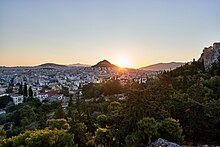
Athens has a hot-summer Mediterranean climate (Köppen climate classification: Csa). According to the meteorological station near the city center which is operated by the National Observatory of Athens, the downtown area has an annual average temperature of 19.2 °C (66.6 °F) while parts of the urban agglomeration may reach up to 19.8 °C (67.6 °F), being affected by the urban heat island effect.[55] Athens receives about 433.1 millimetres (17.05 in) of precipitation per year, largely concentrated during the colder half of the year with the remaining rainfall falling sparsely, mainly during thunderstorms. Fog is rare in the city center, but somewhat more frequent in areas to the east, close to mount Hymettus.[56]
The southern section of the Athens metropolitan area (i.e., Elliniko, Athens Riviera) lies in the transitional zone between Mediterranean (Csa) and hot semi-arid climate (BSh), with its port-city of Piraeus being the most extreme example, receiving just 331.9 millimetres (13.07 in) per year. The areas to the south generally see less extreme temperature variations as their climate is moderated by the Saronic gulf.[57] The northern part of the city (i.e., Kifissia), owing to its higher elevation, features moderately lower temperatures and slightly increased precipitation year-round. The generally dry climate of the Athens basin compared to the precipitation amounts seen in a typical Mediterranean climate is due to the rain shadow effect caused by the Pindus mountain range and the Dirfys and Parnitha mountains, substantially drying the westerly[58] and northerly[56] winds respectively.

Snowfall is not very common, though it occurs almost annually, but it usually does not cause heavy disruption to daily life, in contrast to the northern parts of the city, where blizzards occur on a somewhat more regular basis. The most recent examples include the snowstorms of 16 February 2021[59] and 24 January 2022,[60] when the entire urban area was blanketed in snow.
Athens may get particularly hot in the summer, owing partly to the strong
| Climate data for downtown Athens (1991–2020), Extremes (1890–present) | |||||||||||||
|---|---|---|---|---|---|---|---|---|---|---|---|---|---|
| Month | Jan | Feb | Mar | Apr | May | Jun | Jul | Aug | Sep | Oct | Nov | Dec | Year |
| Record high °C (°F) | 22.8 (73.0) |
25.3 (77.5) |
28.2 (82.8) |
32.2 (90.0) |
37.6 (99.7) |
44.8 (112.6) |
42.8 (109.0) |
43.9 (111.0) |
38.7 (101.7) |
36.5 (97.7) |
30.5 (86.9) |
23.1 (73.6) |
44.8 (112.6) |
| Mean daily maximum °C (°F) | 13.3 (55.9) |
14.2 (57.6) |
17.0 (62.6) |
21.1 (70.0) |
26.5 (79.7) |
31.6 (88.9) |
34.3 (93.7) |
34.3 (93.7) |
29.6 (85.3) |
24.4 (75.9) |
18.9 (66.0) |
14.4 (57.9) |
23.3 (73.9) |
| Daily mean °C (°F) | 10.2 (50.4) |
10.8 (51.4) |
13.1 (55.6) |
16.7 (62.1) |
21.8 (71.2) |
26.6 (79.9) |
29.3 (84.7) |
29.4 (84.9) |
25.0 (77.0) |
20.3 (68.5) |
15.6 (60.1) |
11.6 (52.9) |
19.2 (66.6) |
| Mean daily minimum °C (°F) | 7.1 (44.8) |
7.3 (45.1) |
9.2 (48.6) |
12.3 (54.1) |
17.0 (62.6) |
21.6 (70.9) |
24.2 (75.6) |
24.4 (75.9) |
20.4 (68.7) |
16.2 (61.2) |
12.2 (54.0) |
8.7 (47.7) |
15.0 (59.0) |
| Record low °C (°F) | −6.5 (20.3) |
−5.7 (21.7) |
−2.6 (27.3) |
1.7 (35.1) |
6.2 (43.2) |
11.8 (53.2) |
16 (61) |
15.5 (59.9) |
8.9 (48.0) |
5.9 (42.6) |
−1.1 (30.0) |
−4.0 (24.8) |
−6.5 (20.3) |
| Average rainfall mm (inches) | 55.6 (2.19) |
44.4 (1.75) |
45.6 (1.80) |
27.6 (1.09) |
20.7 (0.81) |
11.6 (0.46) |
10.7 (0.42) |
5.4 (0.21) |
25.8 (1.02) |
38.6 (1.52) |
70.8 (2.79) |
76.3 (3.00) |
433.1 (17.06) |
| Average relative humidity (%)
|
72.0 | 70.0 | 66.0 | 60.0 | 56.0 | 50.0 | 42.0 | 47.0 | 57.0 | 66.0 | 72.0 | 73.0 | 60.9 |
| Average ultraviolet index | 2 | 3 | 5 | 7 | 9 | 10 | 10 | 9 | 6 | 4 | 2 | 2 | 6 |
| Source 1: Cosmos, scientific magazine of the National Observatory of Athens[66] | |||||||||||||
| Source 2: Meteoclub[67][68] | |||||||||||||
| Climate data for Elliniko, coastal Athens (1955–2010), Extremes (1957–present) | |||||||||||||
|---|---|---|---|---|---|---|---|---|---|---|---|---|---|
| Month | Jan | Feb | Mar | Apr | May | Jun | Jul | Aug | Sep | Oct | Nov | Dec | Year |
| Record high °C (°F) | 22.4 (72.3) |
24.2 (75.6) |
27.0 (80.6) |
30.9 (87.6) |
35.6 (96.1) |
40.0 (104.0) |
42.2 (108.0) |
43.0 (109.4) |
37.2 (99.0) |
35.2 (95.4) |
28.6 (83.5) |
22.9 (73.2) |
43.0 (109.4) |
| Mean daily maximum °C (°F) | 13.6 (56.5) |
14.1 (57.4) |
15.9 (60.6) |
19.6 (67.3) |
24.4 (75.9) |
29.2 (84.6) |
32.2 (90.0) |
32.2 (90.0) |
28.3 (82.9) |
23.4 (74.1) |
18.8 (65.8) |
15.1 (59.2) |
22.2 (72.0) |
| Daily mean °C (°F) | 10.3 (50.5) |
10.6 (51.1) |
12.4 (54.3) |
16.1 (61.0) |
20.9 (69.6) |
25.6 (78.1) |
28.3 (82.9) |
28.2 (82.8) |
24.3 (75.7) |
19.6 (67.3) |
15.4 (59.7) |
11.9 (53.4) |
18.6 (65.5) |
| Mean daily minimum °C (°F) | 7.0 (44.6) |
7.1 (44.8) |
8.5 (47.3) |
11.5 (52.7) |
15.8 (60.4) |
20.3 (68.5) |
23.0 (73.4) |
23.1 (73.6) |
19.6 (67.3) |
15.7 (60.3) |
12.0 (53.6) |
8.8 (47.8) |
14.4 (57.9) |
| Record low °C (°F) | −2.9 (26.8) |
−4.2 (24.4) |
−2.0 (28.4) |
0.6 (33.1) |
8.0 (46.4) |
11.4 (52.5) |
15.5 (59.9) |
16.0 (60.8) |
10.4 (50.7) |
3.0 (37.4) |
1.4 (34.5) |
−2.0 (28.4) |
−4.2 (24.4) |
| Average rainfall mm (inches) | 47.7 (1.88) |
38.5 (1.52) |
42.3 (1.67) |
25.5 (1.00) |
14.3 (0.56) |
5.4 (0.21) |
6.3 (0.25) |
6.2 (0.24) |
12.3 (0.48) |
45.9 (1.81) |
60.1 (2.37) |
62.0 (2.44) |
366.5 (14.43) |
| Average rainy days | 12.9 | 11.4 | 11.3 | 9.3 | 6.4 | 3.6 | 1.7 | 1.6 | 4.7 | 8.6 | 10.9 | 13.5 | 95.9 |
| Average relative humidity (%)
|
69.3 | 68.0 | 65.9 | 62.2 | 58.2 | 51.8 | 46.6 | 46.8 | 54.0 | 62.6 | 69.2 | 70.4 | 60.4 |
| Mean monthly sunshine hours | 130.2 | 134.4 | 182.9 | 231.0 | 291.4 | 336.0 | 362.7 | 341.0 | 276.0 | 207.7 | 153.0 | 127.1 | 2,773.4 |
| Source 1: HNMS (1955–2010 normals)[69]
| |||||||||||||
| Source 2: Deutscher Wetterdienst (Extremes 1961–1990),[70] Info Climat (Extremes 1991–present)[71][72] | |||||||||||||
| Climate data for Nea Filadelfia , Athens (1955–2010)
| |||||||||||||
|---|---|---|---|---|---|---|---|---|---|---|---|---|---|
| Month | Jan | Feb | Mar | Apr | May | Jun | Jul | Aug | Sep | Oct | Nov | Dec | Year |
| Mean daily maximum °C (°F) | 12.6 (54.7) |
13.6 (56.5) |
16.0 (60.8) |
20.3 (68.5) |
26.2 (79.2) |
31.4 (88.5) |
33.8 (92.8) |
33.6 (92.5) |
29.2 (84.6) |
23.5 (74.3) |
18.1 (64.6) |
14.1 (57.4) |
22.7 (72.9) |
| Daily mean °C (°F) | 8.8 (47.8) |
9.3 (48.7) |
11.3 (52.3) |
15.3 (59.5) |
21.0 (69.8) |
26.0 (78.8) |
28.3 (82.9) |
27.8 (82.0) |
23.4 (74.1) |
18.4 (65.1) |
13.7 (56.7) |
10.2 (50.4) |
17.8 (64.0) |
| Mean daily minimum °C (°F) | 5.4 (41.7) |
5.5 (41.9) |
6.9 (44.4) |
9.9 (49.8) |
14.2 (57.6) |
18.7 (65.7) |
21.3 (70.3) |
21.2 (70.2) |
17.6 (63.7) |
13.8 (56.8) |
10.0 (50.0) |
6.9 (44.4) |
12.6 (54.7) |
| Average precipitation mm (inches) | 53.9 (2.12) |
43.0 (1.69) |
41.8 (1.65) |
28.5 (1.12) |
20.5 (0.81) |
9.1 (0.36) |
7.0 (0.28) |
6.7 (0.26) |
19.4 (0.76) |
48.8 (1.92) |
61.9 (2.44) |
71.2 (2.80) |
411.8 (16.21) |
| Average precipitation days | 12.0 | 10.6 | 10.2 | 8.3 | 5.8 | 3.4 | 1.9 | 1.6 | 4.1 | 7.4 | 10.1 | 12.5 | 87.9 |
| Average relative humidity (%)
|
74.4 | 72.0 | 68.4 | 61.7 | 53.4 | 45.7 | 42.9 | 45.4 | 54.6 | 66.1 | 74.5 | 76.2 | 61.3 |
| Source: HNMS[73]
| |||||||||||||
Administration


Athens became the capital of Greece in 1834, following
The large City Centre (
Athens Urban Area
The Athens Urban Area (Greek: Πολεοδομικό Συγκρότημα Αθηνών), also known as Urban Area of the Capital (Greek: Πολεοδομικό Συγκρότημα Πρωτεύουσας) or Greater Athens (Greek: Ευρύτερη Αθήνα),[75] today consists of 40 municipalities, 35 of which make up what was referred to as the former Athens Prefecture municipalities, located within 4 regional units (North Athens, West Athens, Central Athens, South Athens); and a further 5 municipalities, which make up the former Piraeus Prefecture municipalities, located within the regional unit of Piraeus as mentioned above.
The Athens Municipality forms the core and center of Greater Athens, which in its turn consists of the Athens Municipality and 40 more municipalities, divided in four regional units (Central, North, South and West Athens), accounting for 2,611,713 people (in 2021)[3] within an area of 361 km2 (139 sq mi).[7] Until 2010, which made up the abolished Athens Prefecture and the municipality of Piraeus, the historic Athenian port, with 4 other municipalities make up the regional unit of Piraeus. The regional units of Central Athens, North Athens, South Athens, West Athens and Piraeus with part of East[76] and West Attica[77] regional units combined make up the continuous Athens Urban Area,[77][78][79] also called the "Urban Area of the Capital" or simply "Athens" (the most common use of the term), spanning over 412 km2 (159 sq mi),[80] with a population of 3,059,764 people as of 2021. The Athens Urban Area is considered to form the city of Athens as a whole, despite its administrative divisions, which is the largest in Greece and the 9th most populated urban area in Europe.
| |||||||||||||||||||||||
|

|
| |||||||||||||||||||||
| |||||||||||||||||||||||
|
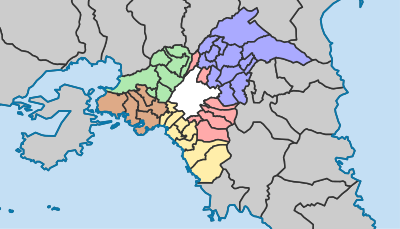
|
Athens metropolitan area

The Athens metropolitan area spans 2,928.717 km2 (1,131 sq mi) within the Attica region and includes a total of 58 municipalities, which are organized in seven regional units (those outlined above, along with East Attica and West Attica), having reached a population of 3,638,281 according to the 2021 census.[3] Athens and Piraeus municipalities serve as the two metropolitan centres of the Athens Metropolitan Area.[81] There are also some inter-municipal centres serving specific areas. For example, Kifissia and Glyfada serve as inter-municipal centres for northern and southern suburbs respectively.


The
).The Athens city coastline, extending from the major commercial port of Piraeus to the southernmost suburb of Varkiza for some 25 km (20 mi),[83] is also connected to the City Centre by tram.
In the northern suburb of Maroussi, the upgraded main Olympic Complex (known by its Greek acronym OAKA) dominates the skyline. The area has been redeveloped according to a design by the Spanish architect Santiago Calatrava, with steel arches, landscaped gardens, fountains, futuristic glass, and a landmark new blue glass roof which was added to the main stadium. A second Olympic complex, next to the sea at the beach of Palaio Faliro, also features modern stadia, shops and an elevated esplanade. Work is underway to transform the grounds of the old Athens Airport – named Elliniko – in the southern suburbs, into one of the largest landscaped parks in Europe, to be named the Hellenikon Metropolitan Park.[84]
Many of the southern suburbs (such as
Twin towns – sister cities
The concept of a partner city is used under different names in different countries, but they mean the same thing, that two cities in different countries assist each other as partners. Athens has quite a number of partners, whether as a "twin", a "sister", or a "partner."
Demographics
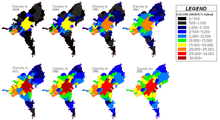
The Municipality of Athens has an official population of 643,452 people (in 2021).
The municipality (Center) of Athens is the
For the Athenians the most popular way of dividing the downtown is through its neighbourhoods such as
Romani people are concentrated in Ano Liosia, Agia Varvara, Zefeiri and Kamatero.[87]
There is a large Albanian community in Athens.[88]
Metropolitan Area
The Athens Metropolitan Area, with an area of 2,928.717 km2 (1,131 sq mi) and inhabited by 3,744,059 people in 2021,[3] consists of the Athens Urban Area with the addition of the towns and villages of East and West Attica, which surround the dense urban area of the Greek capital. It actually sprawls over the whole peninsula of Attica, which is the best part of the region of Attica, excluding the islands.
| Classification of regional units within Greater Athens, Athens Urban Area and Athens Metropolitan Area | |||||
|---|---|---|---|---|---|
| Regional unit | Population (2021)[3] | Land Area (km2) | Area | ||
| Central Athens | 1,002,212 | 87.4 | Greater Athens 2,611,713 364.2 km2 |
Athens Urban Area 3,059,764 414.6 km2 |
Athens Metropolitan Area 3,744,059 2931.6 km2 |
| North Athens | 601,163 | 140.7 | |||
| South Athens | 529,455 | 69.4 | |||
| West Athens | 478,883 | 66.7 | |||
| Piraeus | 448,051 | 50.4 | Greater Piraeus 448,051 50.4 km2 | ||
| East Attica | 518,755 | 1,513 | |||
| West Attica | 165,540 | 1,004 | |||
Safety
Athens ranks in the lowest percentage for the risk on frequency and severity of terrorist attacks according to the EU Global Terrorism Database (EIU 2007–2016 calculations). The city also ranked 35th in Digital Security, 21st on Health Security, 29th on Infrastructure Security and 41st on Personal Security globally in a 2017 The Economist Intelligence Unit report.[89] It also ranks as a very safe city (39th globally out of 162 cities overall) on the ranking of the safest and most dangerous countries.[90] As May 2022 the crime index from Numbeo places Athens at 56.33 (moderate), while its safety index is at 43.68.Crime in Athens[91] According to a Mercer 2019 Quality of Living Survey, Athens ranks 89th on the Mercer Quality of Living Survey ranking.[92]
Economy



Athens is the financial capital of Greece. According to data from 2014, Athens as a metropolitan economic area produced US$130 billion as GDP in PPP, which consists of nearly half of the production for the whole country. Athens was ranked 102nd in that year's list of global economic metropolises, while GDP per capita for the same year was 32,000 US-dollars.[95]
Athens is one of the major economic centres in south-eastern Europe and is considered a regional economic power. The port of Piraeus, where big investments by COSCO have already been delivered during the recent decade, the completion of the new Cargo Centre in Thriasion,[96] the expansion of the Athens Metro and the Athens Tram, as well as the Hellenikon metropolitan park redevelopment in Elliniko and other urban projects, are the economic landmarks of the upcoming years.
Prominent Greek companies such as
Tourism is also a leading contributor to the economy of the city, as one of Europe's top destinations for city-break tourism, and also the gateway for excursions to both the islands and other parts of the mainland. Greece attracted 26.5 million visitors in 2015, 30.1 million visitors in 2017, and over 33 million in 2018, making Greece one of the most visited countries in Europe and the world, and contributing 18% to the country's GDP. Athens welcomed more than 5 million tourists in 2018, and 1.4 million were "city-breakers"; this was an increase by over a million city-breakers since 2013.[98]
Tourism
Athens has been a destination for travellers since antiquity. Over the past decade, the city's infrastructure and social amenities have improved, in part because of its successful bid to stage the 2004 Olympic Games. The Greek Government, aided by the EU, has funded major infrastructure projects such as the state-of-the-art Eleftherios Venizelos International Airport,[99] the expansion of the Athens Metro system,[53] and the new Attiki Odos Motorway.[53]
Transport
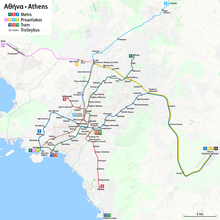
Athens is the country's major transportation hub. The city has Greece's largest airport and its largest port; Piraeus, too, is the largest container transport port in the Mediterranean, and the largest passenger port in Europe.
Athens is a major national hub for Intercity (Ktel) and international buses, as well as for domestic and international rail transport. Public transport is serviced by a variety of transportation means, making up the country's largest mass transit system. Transport for Athens operates a large bus and trolleybus fleet, the city's Metro, a Suburban Railway service[100] and a tram network, connecting the southern suburbs to the city centre.[101]
Bus transport
OSY (Greek: ΟΣΥ) (Odikes Sygkoinonies S.A.), a subsidiary company of OASA (Athens urban transport organisation), is the main operator of buses and trolleybuses in Athens. As of 2017, its network consists of around 322 bus lines, spanning the Athens Metropolitan Area, and making up a fleet of 2,375 buses and trolleybuses. Of those 2,375, 619 buses run on compressed natural gas, making up the largest fleet of natural gas-powered buses in Europe, and 354 are electric-powered (trolleybuses). All of the 354 trolleybuses are equipped to run on diesel in case of power failure.[102]
International links are provided by a number of private companies. National and regional bus links are provided by
Railways
Athens is the hub of the country's national railway system (OSE), connecting the capital with major cities across Greece and abroad (Istanbul, Sofia, Belgrade and Bucharest).

The Athens Suburban Railway, referred to as the Proastiakos, connects Athens International Airport to the city of Kiato, 106 km (66 mi)[103] west of Athens, via Larissa station, the city's central rail station and the port of Piraeus. The length of Athens's commuter rail network extends to 120 km (75 mi),[103] and is expected to stretch to 281 km (175 mi) by 2010.[103]

The
Line 1 (Green Line) serves 24 stations, and is the oldest line of the Athens metro network. It runs from

The
Athens International Airport

Athens is served by the Athens International Airport (ATH), located near the town of Spata, in the eastern Messoghia plain, some 35 km (22 mi) east of center of Athens.[113] The airport, awarded the "European Airport of the Year 2004" Award,[114] is intended as an expandable hub for air travel in southeastern Europe and was constructed in 51 months, costing 2.2 billion euros. It employs a staff of 14,000.[114]
Ferry
The Port of Piraeus is the largest port in Greece and one of the largest in Europe. Rafina and Lavrio act as alternative ports of Athens, connects the city with numerous Greek islands of the Aegean Sea, Evia and Çeşme in Turkey,[115][116] while also serving the cruise ships that arrive.
Motorways
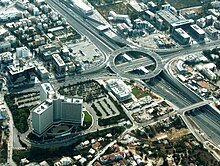
Two main motorways of Greece begin in Athens, namely the
.Athens' Metropolitan Area is served by the motorway network of the
Education
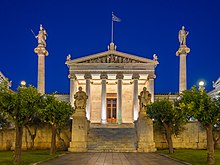
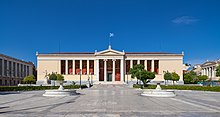

Located on Panepistimiou Street, the old campus of the University of Athens, the National Library, and the Athens Academy form the "Athens Trilogy" built in the mid-19th century. The largest and oldest university in Athens is the National and Kapodistrian University of Athens. Most of the functions of NKUA have been transferred to a campus in the eastern suburb of Zografou. The National Technical University of Athens is located on Patision Street.
The University of West Attica is the second largest university in Athens. The seat of the university is located in the western area of Athens, where the philosophers of Ancient Athens delivered lectures. All the activities of UNIWA are carried out in the modern infrastructure of the three University Campuses within the metropolitan region of Athens (Egaleo Park, Ancient Olive Groove and Athens), which offer modern teaching and research spaces, entertainment and support facilities for all students. Other universities that lie within Athens are the Athens University of Economics and Business, the Panteion University, the Agricultural University of Athens and the University of Piraeus.
There are overall ten state-supported Institutions of Higher (or Tertiary) education located in the Athens Urban Area, these are by chronological order: Athens School of Fine Arts (1837), National Technical University of Athens (1837), National and Kapodistrian University of Athens (1837), Agricultural University of Athens (1920), Athens University of Economics and Business (1920), Panteion University of Social and Political Sciences (1927), University of Piraeus (1938), Harokopio University of Athens (1990), School of Pedagogical and Technological Education (2002), University of West Attica (2018). There are also several other private colleges, as they called formally in Greece, as the establishment of private universities is prohibited by the constitution. Many of them are accredited by a foreign state or university such as the American College of Greece and the Athens Campus of the University of Indianapolis.[118]
Culture
Archaeological hub and museums
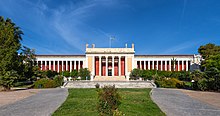

The city is a world centre of
Athens hosts 17 Foreign Archaeological Institutes which promote and facilitate research by scholars from their home countries. As a result, Athens has more than a dozen archaeological libraries and three specialized archaeological laboratories, and is the venue of several hundred specialized lectures, conferences and seminars, as well as dozens of archaeological exhibitions each year. At any given time, hundreds of international scholars and researchers in all disciplines of archaeology are to be found in the city.
Athens' most important museums include:
- the Roman Greece;
- the Benaki Museum with its several branches for each of its collections including ancient, Byzantine, Ottoman-era, Chinese art and beyond;
- the Byzantine and Christian Museum, one of the most important museums of Byzantine art;
- the National Art Gallery, the nation's eponymous leading gallery, which reopened in 2021 after renovation;
- the National Museum of Contemporary Art, which opened in 2000 in a former brewery building;
- the Numismatic Museum, housing a major collection of ancient and modern coins;
- the Museum of Cycladic Art, home to an extensive collection of Cycladic art, including its famous figurines of white marble;
- the New Acropolis Museum, opened in 2009, and replacing the old museum on the Acropolis. The new museum has proved considerably popular; almost one million people visited during the summer period June–October 2009 alone. A number of smaller and privately owned museums focused on Greek culture and arts are also to be found.
- the Kerameikos Archaeological Museum, a museum which displays artifacts from the burial site of Kerameikos. Much of the pottery and other artifacts relate to Athenian attitudes towards death and the afterlife, throughout many ages.
- the Jewish Museum of Greece, a museum which describes the history and culture of the Greek Jewish community.
Architecture
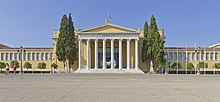
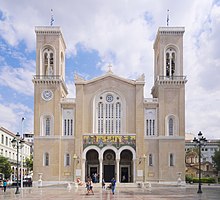
Athens incorporates architectural styles ranging from Greco-Roman and Neoclassical to Modern. They are often to be found in the same areas, as Athens is not marked by a uniformity of architectural style. A visitor will quickly notice the absence of tall buildings: Athens has very strict height restriction laws in order to ensure the Acropolis Hill is visible throughout the city. Despite the variety in styles, there is evidence of continuity in elements of the architectural environment throughout the city's history.[119]
For the greatest part of the 19th century Neoclassicism dominated Athens, as well as some deviations from it such as
Beginning in the 1920s, modern architecture including Bauhaus and Art Deco began to exert an influence on almost all Greek architects, and buildings both public and private were constructed in accordance with these styles. Localities with a great number of such buildings include Kolonaki, and some areas of the centre of the city; neighbourhoods developed in this period include Kypseli.[120]
In the 1950s and 1960s during the extension and development of Athens, other modern movements such as the
Urban sculpture

Across the city numerous statues or busts are to be found. Apart from the neoclassicals by Leonidas Drosis at the Academy of Athens (Plato, Socrates, Apollo and Athena), others in notable categories include the statue of Theseus by Georgios Fytalis at Thiseion; depictions of philhellenes such as Lord Byron, George Canning, and William Gladstone; the equestrian statue of Theodoros Kolokotronis by Lazaros Sochos in front of the Old Parliament; statues of Ioannis Kapodistrias, Rigas Feraios and Adamantios Korais at the University; of Evangelos Zappas and Konstantinos Zappas at the Zappeion; Ioannis Varvakis at the National Garden; the" Woodbreaker" by Dimitrios Filippotis; the equestrian statue of Alexandros Papagos in the Papagou district; and various busts of fighters of Greek independence at the Pedion tou Areos. A significant landmark is also the Tomb of the Unknown Soldier in Syntagma.
Entertainment and performing arts
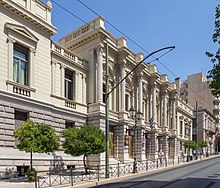
Athens is home to 148 theatrical stages, more than any other city in the world, including the ancient
Restaurants, tavernas and bars can be found in the entertainment hubs in Plaka and the Trigono areas of the historic centre, the inner suburbs of Gazi and Psyrri are especially busy with nightclubs and bars, while Kolonaki, Exarchia, Metaxourgeio, Koukaki and Pangrati offer more of a cafe and restaurant scene. The coastal suburbs of Microlimano, Alimos and Glyfada include many tavernas, beach bars and busy summer clubs.

The most successful songs during the period 1870–1930 were the Athenian serenades (Αθηναϊκές καντάδες), based on the
In 1922, following the war, genocide and later population exchange suffered by the Greek population of Asia Minor, many ethnic Greeks fled to Athens. They settled in poor neighbourhoods and brought with them
The renowned American-born Greek soprano Maria Callas spent her teenage years in Athens, where she settled in 1937.[131][132] Her professional opera career started in 1940 in Athens, with the Greek National Opera.[133] In 2018, the city's municipal Olympia Theatre was renamed to "Olympia City Music Theatre 'Maria Callas'"[134][135] and in 2023, the Municipality inaugurated the Maria Callas Museum, housing it in a neoclassical building on 44 Mitropoleos street.[136]
Sports


Athens has a long tradition in sports and sporting events, serving as home to the most important clubs in Greek sport and housing a large number of sports facilities. The city has also been host to sports events of international importance.
Athens has hosted the
Athens has hosted the
Athens is home to three European multi-sport clubs:
Other notable clubs within Athens are
Athenian clubs have also had domestic and international success in other sports.The Athens area encompasses a variety of terrain, notably hills and mountains rising around the city, and the capital is the only major city in Europe to be bisected by a mountain range. Four mountain ranges extend into city boundaries and thousands of kilometres of trails criss-cross the city and neighbouring areas, providing exercise and wilderness access on foot and bike.
Beyond Athens and across the prefecture of Attica, outdoor activities include skiing, rock climbing, hang gliding and windsurfing. Numerous outdoor clubs serve these sports, including the Athens Chapter of the Sierra Club, which leads over 4,000 outings annually in the area.
Athens was awarded the 2004 Summer Olympics on 5 September 1997 in Lausanne, Switzerland, after having lost a previous bid to host the 1996 Summer Olympics, to Atlanta, United States.[21] It was to be the second time Athens would host the games, following the inaugural event of 1896. After an unsuccessful bid in 1990, the 1997 bid was radically improved, including an appeal to Greece's Olympic history. In the last round of voting, Athens defeated Rome with 66 votes to 41.[21] Prior to this round, the cities of Buenos Aires, Stockholm and Cape Town had been eliminated from competition, having received fewer votes.[21] Although the heavy cost was criticized, estimated at $1.5 billion, Athens was transformed into a more functional city that enjoys modern technology both in transportation and in modern urban development.[139] The games welcomed over 10,000 athletes from all 202 countries.[139]
See also
References
- ^ "Athens: City of Wisdom". Washington Independent Review of Books. 30 March 2022. Retrieved 10 September 2022.
- ^ "Athens and Jerusalem: City of Reason, City of Faith". RANE Network. 15 July 2022. Retrieved 18 October 2022.
- ^ a b c d e f g h i j "Census 2021 GR" (PDF) (Press release). Hellenic Statistical Authority. 19 July 2022. Archived (PDF) from the original on 9 October 2022. Retrieved 12 September 2022.
- ^ "Gross domestic product (GDP) at current market prices by metropolitan regions".
- ISBN 0-582-05383-8.
- ^ a b "Population & housing census 2001 (incl. area and average elevation)" (PDF) (in Greek). National Statistical Service of Greece. Archived from the original (PDF) on 21 September 2015.
- ^ a b c "Characteristics". Hellenic Interior Ministry. ypes.gr. Archived from the original on 4 January 2007. Retrieved 6 January 2007.
- ^ Vinie Daily, Athens, the city in your pocket, p. 6.
- ^ Greenberg, Mike; PhD (23 February 2021). "Athena Facts: Things that not many people know about..." Retrieved 20 February 2024.
- ^ "Contents and Principles of the Programme of Unification of the Archaeological Sites of Athens". Hellenic Ministry of Culture. yppo.gr. Archived from the original on 21 August 2016. Retrieved 31 December 2009.
- ^ CNN & Associated Press (16 January 1997). "Greece uncovers 'holy grail' of Greek archeology". CNN. Archived from the original on 6 December 2007. Retrieved 28 March 2007.
- ^ Encarta Ancient Greece from the Internet Archive– Retrieved on 28 February 2012. Archived 31 October 2009.
- ^ a b "Athens". Archived from the original on 6 January 2009. Retrieved 31 December 2008.
Ancient Greek Athenai, historic city and capital of Greece. Many of classical civilization's intellectual and artistic ideas originated there, and the city is generally considered to be the birthplace of Western civilization
- ^ a b BBC History on Greek Democracy Archived 19 December 2019 at the Wayback Machine – Accessed on 26 January 2007
- ^ "The World According to GaWC 2020". GaWC – Research Network. Globalization and World Cities. Archived from the original on 24 August 2020. Retrieved 31 August 2020.
- ^ "Maritime passenger statistics". Eurostat. Eurostat. 21 November 2022. Retrieved 25 March 2023.
- ^ "World Shipping Council- Top 50 Ports". World Shipping Council. Retrieved 7 July 2022.
- ^ Monthly Statistical Bulletin of Greece, December 2012. ELSTAT. 2012. p. 64.
- ^ "Μόνιμος Πληθυσμός – ELSTAT". www.statistics.gr. Archived from the original on 5 January 2023. Retrieved 10 June 2023.
- ^ "Athens, Greece Metro Area Population 1950–2023". www.macrotrends.net. Retrieved 2 March 2023.
- ^ a b c d CNN & Sports Illustrated (5 September 1997). "Sentiment a factor as Athens gets 2004 Olympics". sportsillustrated.cnn.com. Archived from the original on 19 May 2008. Retrieved 28 March 2007.
- ^ As for example in Od.7.80 Archived 18 April 2021 at the Wayback Machine
- ^ Beekes, Robert S. P.(2009), Etymological Dictionary of Greek, Leiden and Boston: Brill, p. 29
- ^ ISBN 0-674-36281-0
- ^ ISBN 0-500-27048-1
- ^ ISBN 978-1-4549-0908-8.
- ^ Great Greek Encyclopedia, vol. II, Athens 1927, p. 30.
- ^ "ToposText". topostext.org. Archived from the original on 25 February 2021. Retrieved 27 March 2020.
- JSTOR 287478.
- ^ 'General Storia' (Global History)
- ^ Osmanlı Yer Adları, Ankara 2017, s.v. full text Archived 31 July 2020 at the Wayback Machine
- ^ "v4.ethnos.gr – Οι πρώτοι… Αθηναίοι". Ethnos.gr. July 2011. Archived from the original on 21 July 2011. Retrieved 26 October 2018.
- ^ S. Immerwahr, The Athenian Agora XIII: the Neolithic and Bronze Ages, Princeton 1971
- ^ ISBN 0-609-80815-X.
- ^ Iakovides, S. 1962. 'E mykenaïke akropolis ton Athenon'. Athens.
- ^ Desborough, Vincent R. d'A (1964). The Last Mycenaeans and Their Successors; an Archaeological Survey, c. 1200–c. 1000 B.C. Oxford: Clarendon Press. p. 113.
- JSTOR 148450– via JSTOR.
- ^ Osborne, R. 1996, 2009. Greece in the Making 1200–479 BC.
- ISBN 978-1400834303. Archivedfrom the original on 12 March 2020. Retrieved 24 December 2014.
- ^ Xenophon, Hellenica, 2.2.20, 404/3
- ^ Kouremenos, Anna (2022). "'The City of Hadrian and not of Theseus': A Cultural History of Hadrian's Arch". In A. Kouremenos (ed.) The Province of Achaea in the 2nd century CE: The Past Present. London: Routledge. https://www.academia.edu/43746490/_2022_The_City_of_Hadrian_and_not_of_Theseus_a_cultural_history_of_Hadrians_Arch
- ^ ISBN 978-0-19-504652-6.
- ^ Alan Cameron, "The Last Days of the Academy at Athens," in A. Cameron, Wandering Poets and Other Essays on Late Greek Literature and Philosophy, 2016, (Oxford University Press: Oxford), pp. 205–246
- ^ ISBN 90-04-08114-3.
- ISBN 978-1-84511-505-0.
- ^ "and (Dontas, The Acropolis and its Museum, 16)". Ancient-greece.org. 21 April 2007. Retrieved 22 March 2009.
- ISBN 978-0720116083.
- ^ "Focus on Athens" (PDF). UHI Quarterly Newsletter, Issue 1, May 2009, page 2. urbanheatisland.info. Archived from the original (PDF) on 22 July 2013. Retrieved 18 March 2011.
- ^ "Welcome!!!". Parnitha-np.gr. Archived from the original on 28 January 2019. Retrieved 10 June 2009.
- ^ "Acropolis: Threat of Destruction". Time. 31 January 1977. Archived from the original on 30 September 2007. Retrieved 3 April 2007.
- ^ a b c d Kitsantonis, Niki (16 July 2007). "As forest fires burn, suffocated Athens is outraged". International Herald Tribune. Archived from the original on 18 September 2007. Retrieved 3 February 2008.
- ^ Συνέντευξη Τύπου Γ. Σουφλιά για την Πάρνηθα (Press release) (in Greek). Hellenic Ministry for the Environment, Physical Planning, & Public Works. 18 July 2007. Archived from the original (.doc) on 16 February 2008. Retrieved 15 January 2008.
Συνολική καμένη έκταση πυρήνα Εθνικού Δρυμού Πάρνηθας: 15.723 (Σύνολο 38.000)
- ^ a b c "Olympic Games 2004: five major projects for Athens". European Union Regional Policy. ec.europa.eu. Archived from the original on 20 May 2007. Retrieved 5 April 2007.
- ^ "Eaxa :: Ενοποιηση Αρχαιολογικων Χωρων Αθηνασ Α.Ε". Astynet.gr. Archived from the original on 28 February 2009. Retrieved 21 March 2009.
- ^ "Climate Atlas of Greece". Hellenic National Meteorological Service. Archived from the original on 4 February 2022. Retrieved 10 April 2022.
- ^ a b "Practical Information About Athens". www.ippcathens2024.gr. Retrieved 31 May 2023.
- ISSN 1352-2310.
- ^ "Mountain Weather in Greece : Articles : SummitPost". www.summitpost.org. Retrieved 31 May 2023.
- ^ "Unusually heavy snow blankets Athens – in pictures". The Guardian. 16 February 2021. Archived from the original on 21 December 2021. Retrieved 21 December 2021.
- ^ "Severe weather brings snow to Athens, Greek islands". Ekhatimerini. 24 January 2022. Archived from the original on 24 January 2022. Retrieved 24 January 2022.
- ISSN 1352-2310.
- ^ "Athens will be the first European city to appoint a chief heat officer". Fast Company media magazine. Retrieved 10 April 2022.
- ^ "Athens' chief heat officer prepares the city for the climate crisis". euronews. 24 June 2022. Retrieved 8 June 2023.
- ^ "World Meteorological Organization's World Weather & Climate Extremes Archive". Arizona State University website. World Meteorological Organization. Archived from the original on 24 September 2016. Retrieved 23 September 2016.
- ^ "WMO is monitoring potential new temperature records". public.wmo.int. 17 July 2023. Retrieved 17 July 2023.
- ^ "Το 'νέο' κλίμα της Αθήνας – Περίοδος 1991–2020". National Observatory of Athens. Archived from the original on 21 October 2021. Retrieved 3 July 2021.
- ^ "Το κλίμα της Αθήνας". www.meteoclub.gr. Archived from the original on 21 October 2021. Retrieved 3 July 2021.
- ^ "Το αρχείο του Θησείου". www.meteoclub.gr. Archived from the original on 4 May 2016. Retrieved 1 May 2016.
- ^ "Climatic Data for selected stations in Greece: Elliniko (Elliniko)". Archived from the original on 5 February 2021. Retrieved 5 February 2021.
- ^ "Klimatafel von Athen Flughafen (Hellinikon) / Griechenland" (PDF). Baseline climate means (1961–1990) from stations all over the world. Deutscher Wetterdienst. Archived (PDF) from the original on 12 June 2020. Retrieved 15 May 2020.
- ^ "Climatic Data for selected stations in Greece: Athens Airport". Archived from the original on 5 February 2021. Retrieved 15 May 2020.
- ^ Kapikian, Etienne [@EKMeteo] (9 January 2021). "Aussi 22.4°C #Athènes-Ellinikon record mensuel à la station" (Tweet) (in French). Archived from the original on 9 January 2021. Retrieved 10 January 2021 – via Twitter.
- ^ "Climate: Nea Filadelfia, Attiki (Greece)". Archived from the original on 7 May 2018. Retrieved 5 February 2021.
- ^ "Distance between Athens, Greece and Piraeus, Greece". distances-from.com. 9 December 2007. Archived from the original on 9 February 2018. Retrieved 8 February 2018.
- ^ "Greater Athens (Greece): Municipalities – Population Statistics, Charts and Map". citypopulation.de. Archived from the original on 3 May 2020. Retrieved 24 May 2020.
- ^ "Concise Statistical Yearbook of Greece 2001 page 38, National Statistical Service of Greece" (PDF). Archived (PDF) from the original on 1 July 2019. Retrieved 26 August 2019.
- ^ a b "Αttikh". EraNET (in Greek). Archived from the original on 29 June 2019. Retrieved 8 August 2019.
- ^ "Monthly Statistical Bulletin Monthly Statistical Bulletin December 2012, Hellenic Statistical Authority, page 64" (PDF). Archived (PDF) from the original on 13 July 2020. Retrieved 29 August 2019.
- ^ "Statistical Yearbook of Greece 2001 page 72, National Statistical Service of Greece" (PDF). Archived (PDF) from the original on 1 July 2019. Retrieved 8 August 2019.
- ^ "ΦΕΚ B 1292/2010, Kallikratis reform municipalities" (in Greek). Government Gazette. Archived from the original on 10 October 2021. Retrieved 9 September 2021.
- ^ "Master Plan for Athens and Attica 2021, pg 13, 24, 27, 33, 36, 89". Archived from the original on 21 March 2012.
- ^ "ΕΛΣΤΑΤ Απογραφη 2011" (PDF). statistics.gr. Archived from the original (PDF) on 11 October 2011. Retrieved 22 August 2011.
- ^ "Distance between Piraeus (Attiki) and Varkiza (Piraios Nomos) (Greece)". Distancecalculator.globefeed.com. 9 December 2007. Archived from the original on 11 July 2011. Retrieved 9 June 2009.
- ^ "Hellenikon Metropolitan Park Competition". Hellenic Ministry of the Environment and Public Works. minenv.gr. Archived from the original on 8 April 2004. Retrieved 3 January 2007.
- ^ "Europe | Greek forest fire close to Athens". BBC News. 29 June 2007. Archived from the original on 27 August 2009. Retrieved 9 June 2009.
- ^ "PAGE-themes". statistics.gr. Archived from the original on 6 October 2014. Retrieved 3 October 2014.
- ^ "International Roma Day: The Stigmatized People of Greece".
- ^ "A migrant's story: From Albania to Athens".
- ^ "Safe Cities Index 2017: Security in a rapidly urbanizing world" (PDF). The Economist Intelligent Unit. 9 December 2017. Archived (PDF) from the original on 16 October 2017. Retrieved 8 February 2018.
- ^ "Athens Safety Index". Safe Around. Archived from the original on 29 October 2019. Retrieved 1 September 2019.
- ^ "Is Athens Safe? Areas to Avoid and Other Warnings". Mercer. 26 February 2019. Archived from the original on 16 July 2019. Retrieved 8 February 2019.
- ^ "Athens Has the Biggest Fall in Mercer's 21st Personal Safety Ranking". Mercer. 13 March 2019. Archived from the original on 19 March 2019. Retrieved 8 February 2018.
- ^ "Economy and Banking Sector of Greece". The European Banks.
- ^ "List of Banks in Greece – Overview of Top 10 Greek Banks". ADV Ratings. Retrieved 10 March 2023.
- ^ Parilla, Joseph; Berube, Alan; Leal Trujillo, Jesus; Ran, Tao (22 January 2015). "Global Metro Monitor". Brookings. Archived from the original on 7 January 2019. Retrieved 23 February 2019.
- ^ "Cargo container centers". GAIA OSE. 8 October 2017. Archived from the original on 24 February 2019. Retrieved 24 February 2019.
- ^ "Report for Selected Countries and Subjects". International Monetary Fund. Archived from the original on 24 February 2019. Retrieved 24 February 2019.
- ^ "Εξαπλασιάστηκαν σε μία πενταετία οι τουρίστες στην πρωτεύουσα, Του Ηλία Μπέλλου". Kathimerini. 8 March 2018. Archived from the original on 24 February 2019. Retrieved 24 February 2019.
- ^ "Financial Statements as at 31 December 2007" (PDF). Athens International Airport, S.A. Archived from the original (PDF) on 5 February 2009. Retrieved 5 April 2007.
- )
- ^ "The tram of Athens". Tram Sa. Archived from the original on 14 January 2009. Retrieved 5 January 2009.
- ^ "Στόλος λεωφορείων". Ο.ΣΥ. Α.Ε. (in Greek). Archived from the original on 17 April 2021. Retrieved 28 March 2021.
- ^ a b c "Proastiakos". proastiakos.gr. Archived from the original on 3 February 2009. Retrieved 9 June 2009.
- ^ "Athens Metro". Hellenic Ministry of Culture. culture.gr. Archived from the original on 7 December 2006. Retrieved 26 January 2007.
- ^ a b c d "Athens Urban Transport Network in Facts and Figures (pdf) page 15" (PDF). OASA. oasa.gr. Archived from the original (PDF) on 29 June 2006. Retrieved 4 February 2007.
- ^ "Homepage – The Company – Attiko Metro S.A." Attiko Metro S.A. Archived from the original on 3 December 2010. Retrieved 2 June 2014.
- ^ "Line3". Attiko Metro. ametro.gr.
- ^ "Athens Greece Guide". Athensguide.org.
- ^ a b c d e "Tram Sa". Tramsa.gr. Archived from the original on 21 July 2011. Retrieved 25 October 2009.
- ^ "Alstom introduces the Citadis X05 tram to Athens". Alstom. Retrieved 19 April 2023.
- ^ "Athens Urban Transport Network in Facts and Figures (pdf) page 13" (PDF). OASA. oasa.gr. Archived from the original (PDF) on 29 June 2006. Retrieved 28 January 2007.
- ^ "Tram Sa". Tramsa.gr. Archived from the original on 21 July 2011. Retrieved 25 October 2009.
- ^ "Athens International Airport: Facts and Figures". Athens International Airport. aia.gr. Archived from the original on 6 April 2008. Retrieved 11 February 2007.
- ^ a b "Athens International Airport: Airport Profile". Athens International Airport. aia.gr. Archived from the original on 7 June 2007. Retrieved 11 February 2007.
- ^ sabah, daily (1 July 2019). "Çeşme-Athens ferry services for passenger, freight transport begin". Daily Sabah. Archived from the original on 7 July 2019. Retrieved 7 July 2019.
- ^ Kokkinidis, Tasos. "Turkish Company Launches Ferry Services Between Athens and Izmir | GreekReporter.com". Archived from the original on 7 July 2019. Retrieved 7 July 2019.
- ^ "Aodos.gr".[permanent dead link]
- ^ "Ιδιωτικά Πανεπιστήμια στην Ελλάδα – Private Universities in Greece". www.thought.de. Archived from the original on 25 June 2012. Retrieved 12 June 2012.
- . Retrieved 4 July 2022.
- ISBN 960-6691-38-1
- ISBN 960-6691-38-1
- ^ "Home Page". Urban Audit. Archived from the original on 6 February 2009. Retrieved 21 March 2009.
- ^ "Athens – Epidaurus Festival 2008". Greekfestival.gr. Archived from the original on 22 February 2009. Retrieved 21 March 2009.
- ^ "Megaron Events Chart". Megaron.gr. 26 October 1997. Archived from the original on 1 February 2009. Retrieved 21 March 2009.
- ^ Ίδρυμα Ευγενίδου. Εκπαιδευτικό Κοινωφελές Ίδρυμα (in Greek). Eugenfound.edu.gr. Archived from the original on 8 June 2008. Retrieved 21 March 2009.
- ^ Rizzo, Demetrio. "Athens Today". athens-today.com. Archived from the original on 28 November 2020. Retrieved 29 May 2020.
- ^ "Athens Eugenides Planetarium". Barco. Archived from the original on 7 July 2011. Retrieved 16 June 2011.
- ^ "Vision". SNFCC. Archived from the original on 16 November 2016. Retrieved 16 November 2016.
- ^ "Athens: Books everywhere". UNESCO. 29 March 2018. Archived from the original on 23 April 2022. Retrieved 31 March 2022.
- ^ ISBN 9780955209031. Archivedfrom the original on 5 February 2021. Retrieved 24 October 2013.
- ISBN 978-0-312-51448-8.
- ISBN 978-1-57467-059-2.
- ISBN 978-1-57467-059-2.
- ^ "Olympia | ΟΛΥΜΠΙΑ ΔΗΜΟΥ ΑΘΗΝΑΙΩΝ". 24 February 2023. Retrieved 31 October 2023.
- ^ Βατόπουλος, Νίκος (30 November 2018). ""Ολύμπια", η μεγάλη επιστροφή". Η ΚΑΘΗΜΕΡΙΝΗ (in Greek). Retrieved 31 October 2023.
- ^ IEFIMERIDA.GR, NEWSROOM (25 October 2023). "Maria Callas museum, first in the world, opens in central Athens". iefimerida.gr (in Greek). Retrieved 29 October 2023.
- ^ "Athens 21st Century – Athens Olympic Stadium". Athens-today.com. Archived from the original on 16 February 2009. Retrieved 26 December 2008.
- ^ "Athens 21st Century – The Olympic Coastal Complex". Athens-today.com. Archived from the original on 14 February 2009. Retrieved 26 December 2008.
- ^ a b "Athens bids farewell to the Games". CNN. 30 August 2004. Archived from the original on 15 January 2008. Retrieved 29 March 2007.
External links
- Official website of the Municipality of Athens









